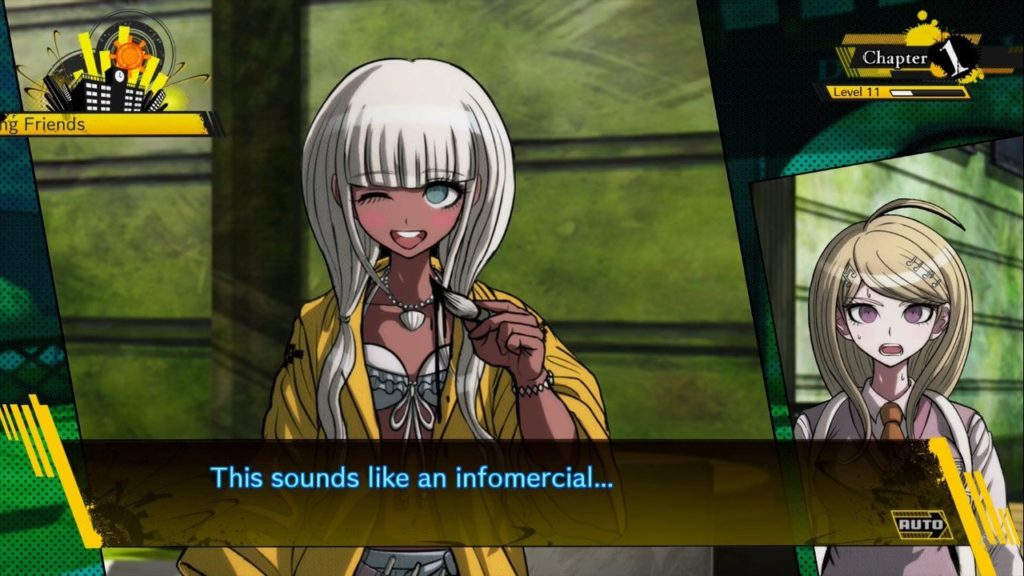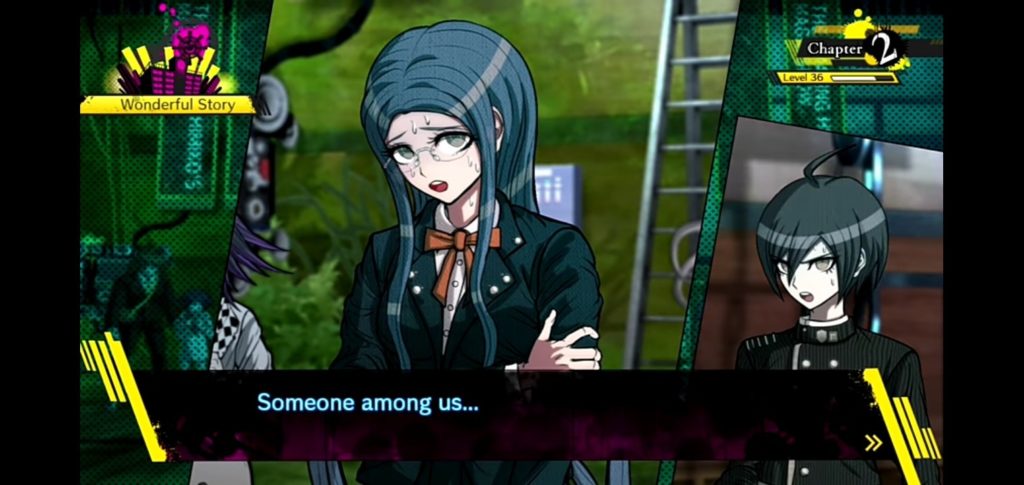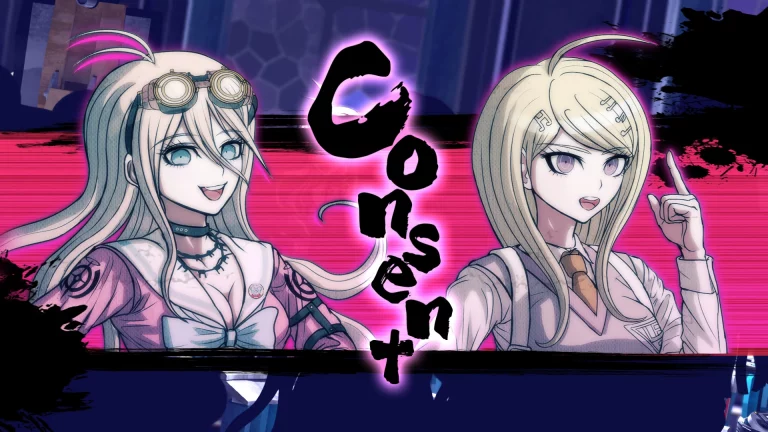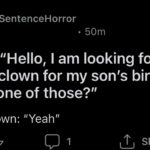As I can easily do an entire TED Talk on the subject (and as I have to think about it A Lot for my own interactive projects) and I’m sure others might find this interesting, I’ve decided to start a series of posts on interactive fiction. Specifically, the unique things a story does to achieve a certain effect that can only be done in this medium.
Images are either from the Danganronpa Out of Context Twitter or the Danganronpa Fan wiki.
[spoiler warning] This post will have spoilers for all 3 mainline Danganronpa games (1, 2, and v3), but especially so for v3, as I’ll be going over one case in detail.
Before we get into the specifics of v3 and how the user interface (UI) is used to uniquely tell the story, we have to go over how it’s different from the others. With each game, the UI is updated, both to clarify and to add new features. Danganronpa has always been a heavily-stylized game, but especially so in v3, as you can see in the health and focus bars/gauges during the trials. Same information, same mechanics, different presentation.

Danganronpa is mostly a visual novel, where you move forward in conversations, talk to people, and follow a linear story. The trials, while also linear, present you with questions/puzzles that you need to solve through logic or some basic gaming skills. You need to determine what piece of testimony contains the contradiction, for example, and what piece of evidence will refute it. Due to both mechanics and tone, the trials and “daily life” have different UI.
One thing that is consistent is white text denoting that it’s spoken aloud, blue text being internal dialogue, and all textboxes having the name of the current speaker. However, this isn’t always clear.

At this point in the game, you know that Makoto is the main (i.e. player) character (MC) and the person shown here is not him. In scenes where a conversation switches between the MC and another speaker, it’s easy to miss the name box when you’re focusing on the words or characters. Luckily, most characters (especially once their numbers dwindle) have distinct-enough dialogue that you can tell who’s-who by that alone.
However: you only ever see the MC during the class trials. Since you move around the 3D spaces in a first-person point of view and you don’t see your character standing around a room like the others, it can be easy to forget what you look like. This, on some level, is understandable, as visual novels tend to have bland main characters to make it easy for the reader to project onto them. The MCs for 1 and 2 are intentionally bland compared to their ultimate classmates.

So seeing yourself finally is a nice change of pace. But also the UI during the trial is…busy.

Even in simple dialogue, there are character portraits to the left (which might be wiggling or otherwise distracting you) along with rotating text detailing what trial it is. Not to mention how the camera can pan, shake, and even spin 360 degrees.

It’s a little cleaner in 2. And then v3 throws this at us.


The “CLASS TRIAL” text is now slowly spinning behind the characters (diegetically, perhaps?) instead of on top, in a space that only exists for the sake of the player. Character portraits are only half a face, there are tons of angular lines with colors of different opacities, names are at an angle. It’s…a lot. But all of the UI in v3 is A Lot, it’s consistent in that way. It’s a big change from the previous games, but, without it, the first major twist of the game would not have had the same impact.
This is your last warning for major spoilers for Danganronpa v3.
But first let’s jump back, to 2 this time.

DR2 introduced a “jukebox” in the upper left corner that tells you what song is playing and chapter/time/character level info in the upper right. The name of the speaker is horizontal to the left. You see the character you’re talking to and the background behind them, but nothing else; other characters in that scene just fade away. Additional characters speaking will fade in/out, one at a time. Your focus is singular, which is the person in front of you.

v3 changes that. The main box “zooms in” on who’s speaking and moves around to focus on the current speaker, much like your own head would. You can see other characters (and their last-used sprite) in the background or in the periphery. There’s also now “empty space” on either side (you can even see Tsumugi just hanging out to the right). The screen is busier, yes, but the rooms are populated, it’s difficult to forget who else is there with you.


The biggest, and best change, is the inclusion of you, the MC, as a visible part of the conversation. You’re Kaede Akamatsu, there’s no doubt about it, and you’re seeing her face as it reacts to what other people are saying. You’re learning about her as you’re learning about everyone else. The narration is still first person, but it feels more third person as the “camera” is “outside” of the MC’s “head.”
Not all lines in Danganronpa are voiced (v3 has something like 12,000 already), though conversations do have soundbites that can align to what’s being said (“Yo!” “What the hell?” “Good morning!” “Geez.”) or not at all, but still tell us something about the character (“This, too, must be the will of casualty.” “So in the end…” “Special bleeding service!”). In v3, the MC has these now, too. Kaede’s a character, not shoes for the player to fill. She’s still the MC, this is still a video game/visual novel, the narration is still first-person. But she’s her own person, not a generic stand-in for the player to project onto. You’re Kaede, the ultimate pianist, not Makoto or Hajime, the ultimate “I’m just grateful to be here!” It’s a welcome change in a lot of ways.
If, somehow, you’ve gotten this far and don’t know the plot of any given Danganronpa game, it’s thus: 16 students, the best at what they do, are stuck in a location, for mysterious reasons, and the robot bear Monokuma tells them the only way to get out is to murder someone AND get away with it. This is determined at a class trial, with debates, evidence, and minigames, just like a real trial! Each chapter has 1 or 2 people being murdered and ends with the trial. Failure means everyone but the murderer is executed, so the stakes are high.
Kaede, as the unofficial leader of the group, doesn’t want anyone to die. She wants to catch the mastermind and get them all out of here, alive. Everyone’s getting along, and Monokuma is getting impatient. He tells them that, if a body doesn’t show up soon, everyone will be killed. Now with a time limit, Kaede gets the help of Shuichi, the ultimate detective, to help her set up a camera trap in the library, which has a secret door that only the mastermind can go into. She believes that by revealing the mastermind, no one will have to die.
Unfortunately, things do not go as planned. A student is found dead in the library, and the items on him make it clear that there’s no way he’s the mastermind. But did the mastermind do the murder, or someone else?

Like most trials, you don’t have the answer going in. There’s compelling evidence, but nothing conclusive (though if you’re incredibly eagle-eyed, you can notice a subtle change in writing style in a few moments that ultimately point to the truth). You need to talk to other people, see what they say, and hopefully catch the perpetrator slipping up. And, like every game before, the UI shows you that, you know, you’re the MC, Kaede. She’s the one picking evidence to show.

She’s the one agreeing with others. As the MC, naturally, she is steering the case. Suspicion begins to shift to Shuichi, but you know he couldn’t have done it, he was with you the whole time, wasn’t he? And, like every trial before, a moment comes where you’re asked if you know who the culprit is. The MC, like always, says “yes, I do!” Which they have to, in order for you to then make the (correct) choice in a moment. Every question in every trial goes like this, in order for the game to flow smoothly.
But this time…it’s different. Watch until the 3:12 mark.
Kaede doesn’t say who it is, despite knowing. She tells Shuichi to tell everyone. Now the game asks you, dear player, to choose the culprit. And you, the player, choose Kaede. Instead of hearing her admit to the crime, or someone points the finger, it’s an internal monologue from Kaede…and the UI shutting down, as the curtains fall on her, both as a narrator and as a living person. Then the internal monologue is Shuichi’s, the UI blinks to life, and he verbalizes the choice you just made.

Correctly completing a section shows Shuichi’s portrait, with blue elements instead of pink.
The exact moment that the narrative passes the torch from Kaede to Shuichi is the accusation. Kaede, despite being the narrator, kept information from the player. Shuichi realizing — and confronting — the truth happens as the player has to do the same thing. There’s no joy in solving this puzzle or outsmarting a criminal, just that sinking pit of despair that things turned out this way. The barrier between work and reader is all but gone as you’re forced to make the same difficult decision in the same mindset as the MC. Dead-trees books could never dream of something like this.

Because the UI is constantly reminding you who the MC is, it’s impossible to forget the change in protagonists. You, the MC, wake up the day after the execution, heart heavy, unsure of where to go from here. And you, the player, are now controlling a character whose only traits were “shy” and “unsure of himself” and “has a poorly-photoshopped on hat.”
Which leads to another, albeit very silly, signal for the shift in protagonists: the ahoge. All of the Danganronpa MCs have that weird little hair antenna…and Shuichi does, too, once he takes off the hat after Kaede’s execution. In a classical literary sense, it’s symbolic of his stepping out of the shadows and believing in himself, of no longer needing that “security blanket,” or whatever character growth you want to call it. The game does call attention to K1-BO’s ahoge, though, which is visible from the start; it’s more of a Chekov’s ahoge, and you can probably guess what that means.
Each Danganronpa is 6 chapters and takes (roughly) 40 hours to go through the story. This twist happens at about the 5-6 hour mark, most of the game has Shuichi as the MC. For this to work as well as it does, you need to go into the work honestly believing that Kaede is the MC for the entire game. It’s been well over 5 years since v3 has been released…and the marketing materials for the game keep up this ruse, as does much of the fandom.


The art for the game, arguably, has Kaede and Shuichi as a bigger focus due to their size, and yet K1-BO is in the center. The splash art for most of the characters (as seen in the key art above) gives some clue as to who they are. The ultimate tennis player has a racket, the ultimate cosplayer has sewing supplies, the ultimate supreme evil leader is wearing that get-up, lording over everyone else. The two characters whose talents aren’t what’s presented (one can’t remember his, the other is somewhat obviously lying about theirs) have pretty simple, non-specific art.


Kaede’s and Shuichi’s are also pretty plain. You might be able to guess their talent based on their outfits, but their poses and lack of props don’t communicate anything specific. But the other MCs and other “detectives” (I’m including Nagito in this because he pretends to be a detective a few times, he’s a narrative foil to the MC, and also he’s on the Danganronpa Decadence collector’s edition poster with the other detectives) similarly plain splash art. Nothing suspicious here!
When there are line-ups of all the MCs, either it’s only Kaede or it’s Kaede and Shuichi equally. Having two from one game doesn’t necessarily imply that one of them dies pretty early on. Maybe they’re equally important, or you switch back and forth, like that one time Nagito goes into a Saw trap for fun. Marketing materials are usually assumed to be spoiler-free, after all!
So to wrap this up: every “touchpoint” in a creative work can serve a storytelling purpose. The enjoyer of your story is going to use “mechanical” features like UI, chapter breaks, scene transitions, making new save files, etc under certain assumptions. Namely, that these are purely mechanical, exdiegetic elements needed to consume the story. Challenging those assumptions and using them with narrative intent can create really powerful moments. Undertale and Doki Doki Literature Club are other examples of this.
[And as an aside: I have not stopped thinking about this moment since it happened to me, and that was almost a year go as of this post. Emotionally, I have not gotten over it, either; watching the video to put into this post was heart-wrenching. The entire v3 experience, but especially this moment, was the narrative inspiration for <Inspect>. Which should make the prologue make a lot more sense if you know this.]


